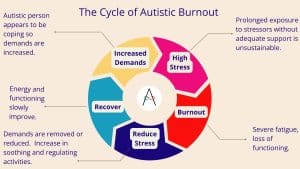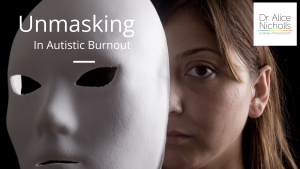Social contact with other human beings can be an immense source of nourishment, joy and support. However, for Autistic People, social contact can be experienced as a demand, increasing our stress levels, and risk of getting in, and staying in, Autistic Burnout.
In this article I will discuss:
- What social demands are
- Why social demands are a source of stress for Autistic People
- Why this is worse in Autistic Burnout
- How to manage social demands when you are in Autistic Burnout
1. What are Social Demands?
Social demands are an expectation, whether implicit or explicit, that you will (at some level) interact, be present or engage in an activity with one or more person.
These demands vary in intensity from someone explicitly saying they expect to interact, talk, see or do something with you to there being a subtle implication that you might interact, talk, see or do something with them.
An interaction could range from seeing someone in the street, or on social media to having a 1:1 conversation.
Being present could range from being in the same building or visibly online at the same time, to giving someone your full attention.
Engaging in an activity could be anything from playing a video game online to working together, in person on a project, task or activity.
And we could be talking about one person, a few or a huge group of people.
Examples of Social Demands:
- Group Whats App messages
- Zoom Calls
- Social Media
- Conversations
- Living with other people
- Caring for children or relatives
- Family meal times
- Washing up with a spouse/partner/housemate
- Drinks after work with friends
- Lunch in the canteen
2. Why are Social Demands so Stressful for Autistic People?
There are many reasons social demands can be stressful for Autistic people, for example:
- Information processing
- Perspective taking
- Unpredictability
- Masking
- Fear of getting it wrong
- Sensory challenges
- The Double Empathy Problem
- Lack of understanding
- Trauma history
- Abusive relationships
Information Processing
Even in the best case scenario, interaction with another person requires additional cognitive processing of information.
Perspective Taking
You are having to think about that person, anticipate or predict what they want from the interaction, and imagine, on some level, what is going on in their head.
You are having to take their perspective and needs into account. Now I strongly believe this is something we as Autistic people can do. but it requires brain power or cognitive capacity. This type of interaction draws on our social energy reserves and, depending on the situation can deplete it pretty quickly.
Unpredictability
Other people are a major source of unpredictability, so you are unable to fully prepare in advance and are required to think on the spot. This is another draw on your cognitive capacity.
Masking
Unless you are interacting with someone with whom you feel very comfortable, you will likely also be doing some level of masking. Trying to appear, interact and respond in a more neurotypical way. You might think you need to appear interested, relaxed and social when you are not feeling that way. This is an additional drain on that limited social battery.
Fear of Getting it Wrong
If you are masking, there is probably also some anxiety that you are not getting it right or that you might make a mistake. This causes more drain on your energy.
Sensory Challenges
Add in the fact that other humans often add additional sensory challenges. Maybe they smell, good or bad, maybe they are noisy, or just make any noise at all and maybe they interfere with the environment, even if that’s in a positive way, it can create additional stimulation and stress. This can, in turn, make processing information required in social situations more difficult.
The Double Empathy Problem
If you are interacting with neurotypical people, they may have difficulty understanding your perspective and you may feel an increased need to mask. This can make interactions more effortful and less rewarding.
Lack of Understanding
If the people you are interacting with don’t understand you and your needs they may try to help in unhelpful ways. For example encouraging you to join a group in a busy room or telling you to face your fear and do it anyway.
Trauma History
I think it’s really important to reflect on our trauma histories too. You have likely had some harmful experiences of interacting with others in the past and this can raise your stress levels, even when there isn’t a current risk.
Abusive Relationships
Unfortunately some of us will have people in our lives who are coe-ercive, controlling and/or abusive. Sometimes the behaviour of other people is just not okay and you shouldn’t be exposed to it at all.
3. Why are social demands so much harder to manage when you are in Autistic Burnout?
Social demands are a stressor for an Autistic person.
When we are not in Autistic Burnout, are well regulated, supported and generally healthy we may be able to manage social demands with relative ease. They may raise our stress levels temporarily but we are able to regulate that stress within our everyday lives.
It is normal for Autistic people to need regular breaks from interaction and time alone after being in a busy social environment. It is also normal for Autistic people to engage in regulating activities such as stimming during a social interaction.
During Autistic Burnout (and in the build up to it) our elevated stress levels make it more difficult to process information (such as spoken language or facial expressions) and to think of responses to questions. We also struggle to filter sensory information more than usual and experience increased sensory sensitivities. This means that we are working harder than usual to process our environments, anticipate what is expected of us and respond appropriately.
If we are in situations where we feel we need to mask, this causes additional stress as we have to concentrate on our facial expressions, body language and suppressing stimulation seeking behaviour. During burnout we have reduced capacity for these tasks and this adds additional stress and anxiety.
Executive functioning problems are usually worse in Autistic Burnout, this means we rely more than usual on predictable, systematic and well rehersed ways of doing things. Other people are often unpredictable and can disrupt our systematic ways of doing things. This can cause us to feel even less able to do what we need to do. It increases our stress levels and may also make us feel anxious that we might be perceived as unreasonable by others.
4. How to Manage Social Demands in Autistic Burnout
There are lots of different ways of managing social demands in Autistic Burnout, it’s important to consider your own situation and work out what works for you. Here are a few ideas:
- Avoidance
- Boundaries
- Reduction
- Adapting the demand
- Having an exit plan
- Taking breaks
- Cushioning
- Unmasking
Avoidance
Avoidance gets a lot of bad press, especially from people who perhaps don’t understand Autism and are focused on treatments for anxiety which often make a case for doing something difficult so you get used to it.
I don’t think this applies in Autistic Burnout. I think that when you are in or at risk of autistic burnout you are already doing too many difficult things and you need to reduce your stress levels wherever you can.
so if you don’t want to do something, and you don’t have to, please consider just avoiding it.
Boundaries
Boundaries are limits or expectations that you can set up either in advance or in the moment, you might communicate them explicitly, for example; putting an out of office automatic response on your emails stating what times you are available by email. or negotiating alone time with friends or family.
You might pre agree how long you will stay somewhere for or what topic’s of conversation or activities are off limits. e.g. “I’ll come to the pub but I won’t be doing karaoke”.
Boundaries could be more implicit, whereby you just don’t engage with some topics of conversation, or you always leave after an hour.
Reduction
Sometimes you can’t avoid something stressful altogether but you can reduce the frequency, intensity or duration. For example: Eating with others once a week rather than every day, Saying you will come for drinks before dinner but not stay for dinner.
Adaptations
Autistic people are often expected to adapt to situations that just don’t suit our neurotype.
It can be helpful, instead, to think of how the situation could be adapted to make it easier to access for you.
You could do this by choosing a venue that you are familiar with and that is more autism friendly, asking for music to be turned down or wearing noise cancelling headphones.
You could also make the demand more manageable by engaging in stimming or making yourself as comfortable as possible by choosing clothing that helps you to feel soothed.
You can request that only one person talks at a time or ask that fewer people are invited. It can also help to make the event more predictable by asking for more information in advance.
Having an Exit Plan
Having an exit plan can help. This could be for the natural end of the event, e.g. I will leave after coffee is served and people start going home or it could be earlier, for example, if you’ve already said you can only stay for an hour you could plan to say goodbye , pick up you things and go at a set time.
It can also help to have an emergency exit plan if you are feeling overwhelmed or stressed earlier than anticipated. You could be honest and say you are not feeling great and need to go or that you’ve remembered you need to go home and do something or you could make something up. It helps to have already thought through what you will say.
Take a Break
Taking breaks within a planned event can help to regulate your stress levels and make the whole event feel more manageable. You can do this without necessarily drawing attention to yourself, for example by going to the bathroom for a few minutes of stretching, asking to go outside to ‘look at the garden’ or popping out to the car or the shop to get something.
Cushioning
Cushioning describes doing something soothing and regulating before and after a stressful event. Regulating your stress levels by engaging in soothing activities before or after a stressful event. This might be for half an hour or even a few days depending on the event. For example you might do 30 minutes of yoga, have a pyjama day or listen to your favourite music before and after an event.
Unmasking
Sometimes situations are more stressful than they need to be because we are masking more than we need to. It does not always feel safe to unmask, but you can consider whether it would feel safe to be less masked in a situation. Being less masked or unmasking might help to reduce some of the stress associated with the demands. You might try to mask less by allowing yourself to stim, not feighning interest or relaxing how much you police your facial expressions.
Summary and Conclusion
Social demands are an expectation, whether implicit or explicit that you will (at some level) interact, be present or engage in an activity with one or more person.
Social demands contribute to Autistic Burnout by causing us stress and limiting our access to soothers.
Social demands cause us stress by drawing on limited energy resources and processing power.
We can limit the impact of social demands by avoiding them, modifying them, putting boundaries in place, taking breaks, having an exit plan and cushioning them with soothers.
I hope this article has been helpful and that you manage to have some meaningful and enjoyable social interactions while also taking care of yourself over the next few weeks.











